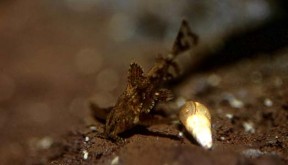Hara jerdoni
Asian Stone Catfish
Classification
Sisoridae
Distribution
India, Bangladesh.
Habitat
Inhabits slow-moving streams and small rivers. It’s preferred habitats are characterised by soft substrates.
Maximum Standard Length
1.2″ (3cm).
Aquarium SizeTop ↑
12″ x 8″ x 8″ (30cm x 20cm x 20cm) – 12.5 litres. Not only is this species tiny, it’s also very inactive, and so doesn’t need much room. If keeping it in a very small tank you must pay extreme care to water parameters (see below).
Maintenance
Provide as many hiding places as possible, along with a soft, sandy substrate. The addition of some dried beech or oak leaves and pieces of driftwood would simulate the natural habitat of the fish nicely. The water must be kept clean, relatively cool and well-oxygenated or the fish will suffer as its natural waters are high in dissolved oxygen.
Water Conditions
Temperature: 64-75°F (18-24°C)
pH: 5.6-7.6
Hardness: 8-15°H
Diet
It will accept most small foods, including dried pellets, but should be offered a diet composed mainly of live and frozen varieties, such as bloodworm, daphnia etc. It’s strictly a noctunal feeder so add food after lights out to ensure it gets its share.
Behaviour and CompatibilityTop ↑
A very peaceful little cat that fits well into communities of other small species, or into a biotope setup with other Asian stream-dwelling species, such as Dario sp. and danios. Don’t keep it with any active bottom-dwelling species or it will be out-competed for food easily. It can be kept with others of its own kind without any problems, and in fact prefers to be kept in a group.
Sexual Dimorphism
Unknown. It is likely that females will appear broader than males when full of eggs.
Reproduction
Has been bred in aquaria, but unfortunately very few details are available. Apparently the eggs were deposited in spawning mops.
NotesTop ↑
This delightful little species can be distinguished from others in the genus by its elongated pectoral spines. It, and others in the genus (and also the closely related genus Erithistes), also go by the common name of moth catfish due to their patterning and shape when viewed from above.



July 23rd, 2014 at 11:00 am
A small correction on the diet part. It prefers bloodworms- frozen or live. These fish also eat the left-overs of the small common black snail when crushed (intentionally). They’re not necessarily nocturnal, they feed as and when they are able to smell food, and their ability to smell food is remarkable. They have no sensitivity to light and do not run into hiding as soon as you turn on the light.
I have these fish from about a year and hence the input.
Hope this was helpful.
Karthik
August 13th, 2014 at 4:29 pm
I have the closely related Hara hara (no article?).
I feed them with the same basic mix of crush flake, granules, spirulina powder that the majority of my nano-fish enjoy, as well as trying out various live/dried foods including microworms which seem more amenable to their small size than bloodworm which is often only available as large specimens. Actually pinning down their preferred option is difficult as its almost impossible to see them feed although they do nuzzle around (day and night!) and are seemingly doing well.
Mine are in a 18*10*10″ (28l) tank with boraras, ricefish and a few surviving shrimp (hopefully to be rehomed soon. I think the 12*8*8 noted is too small especially if keeping more than a pair. Although not free swimmers I do find they actively use the whole of the substrate as well as resting on plants, wood and rock. The extra space would also allow a small shoal of swimmers such as boraras as otherwise these very cryptically marked fish would need a rather bare tank to enable them to be seen effectively – in a nano community their less obvious existence* isn’t such an issue.
*less often seen but certainly not shy. If one is at the front I can walk up, drop in feed, take pictures with flash, even tap on the glass and still it remains unmoved before shuffling off on its own timetable!
February 7th, 2018 at 4:33 pm
Having them for several years now, i also doubt they are nocturnal. Observing them it seems more like they are as blind as a bat and do not make much use of eyesight and have a bad focus. And indeed bloodworms trigger them to come out of hiding anytime. But see them circling the same bloodworm several times bumping into anything on their path before they finaly find it. They also can be extremely active and fly all over the place.
Lovely little fish tho, most remarkable, they can change color tone on the fly, from pepered black, to dark green, to dark or kaky brown, to bleu/grey. Not sure what the trigger to change color is. I assume it changes with the objects color they take a nap on.
Here are a few colors and they where all black the day i got them.
[img]https://www.ukaps.org/forum/attachments/dscf5806-jpg.80956/[/img]
[img]https://www.ukaps.org/forum/attachments/dscf5857-kopie-jpg.80965/[/img]
[img]https://www.ukaps.org/forum/attachments/dscf5849-jpg.80968/[/img]
May 14th, 2020 at 11:46 am
We have kept 6 of these wonderful little fish for several months now. They can swim quite fast when they want to(think in terms of a Cherry Shrimp jetting backwards kind of fast). While this is rare, it does make me uncomfortable keeping them in less than a 10 gallon tank. They do love a good bloodworm. They eat them like they are sucking down a piece of spaghetti. Also they seem to enjoy large Java Moss clumps. Ours spend much of the daylight hours rooting around inside probably feeding on Infusoria and leftovers.
July 19th, 2020 at 9:00 am
Hara jerdoni can be found in Myanmar as well. I learned of a population at the northern outskirts of Yangon about a week ago. I have 6 of them in my care.